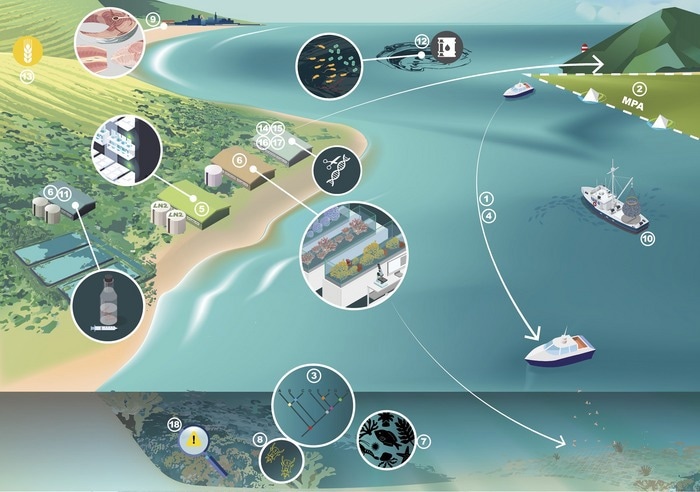In an essay published on October 17th, 2022 in the open-access journal PLOS Biology, Madeleine van Oppen of the Australian Institute of Marine Science and the University of Melbourne and Melinda Coleman of the New South Wales Department of Primary Industries argue that genetic and genomic technologies have tremendous potential for protecting marine life but are currently underutilized.
 Cartoon depicting the conservation actions and interventions addressed in this Essay and showing the major infrastructure required for each. Numbers relate to the following actions/interventions: 1. Genetic rescue (translocation); 2. Marine protected area design and spatial planning; 3. Species identification and delineation; 4. Assisted gene flow (translocation) and restoration (provenance); 5. Biobanking; 6. Assisted evolution (via managed breeding; 7. Biodiversity monitoring; 8. Early warning biomarkers of invasives and pests; 9. Combating illegal fishing and mislabeling; 10. Managing fisheries; 11. Microbiome manipulation; 12. Microbial bioremediation; 13. Alleviating marine stressors ex situ; 14. Provisioning of marine life services ex situ; 15. Evolutionary rescue via genome editing; 16. Pest control; 17. De-extinction; 18. Genomic vulnerability analyses. Image Credit: van Oppen MJH and Coleman MA, 2022, PLOS Biology, CC-BY 4.0
Cartoon depicting the conservation actions and interventions addressed in this Essay and showing the major infrastructure required for each. Numbers relate to the following actions/interventions: 1. Genetic rescue (translocation); 2. Marine protected area design and spatial planning; 3. Species identification and delineation; 4. Assisted gene flow (translocation) and restoration (provenance); 5. Biobanking; 6. Assisted evolution (via managed breeding; 7. Biodiversity monitoring; 8. Early warning biomarkers of invasives and pests; 9. Combating illegal fishing and mislabeling; 10. Managing fisheries; 11. Microbiome manipulation; 12. Microbial bioremediation; 13. Alleviating marine stressors ex situ; 14. Provisioning of marine life services ex situ; 15. Evolutionary rescue via genome editing; 16. Pest control; 17. De-extinction; 18. Genomic vulnerability analyses. Image Credit: van Oppen MJH and Coleman MA, 2022, PLOS Biology, CC-BY 4.0
Humans have impacted every area of global oceans, and vital ecosystems like coral reefs, seagrasses, and kelp forests are all under decline as a result of climate change and other human disturbances.
Van Oppen and Coleman argue in their essay that using genetic and genomic approaches, both through conventional methods and more recent innovations like assisted evolution, has enormous promise for furthering marine conservation and restoration.
For instance, DNA sequencing can now detect marine products that have been unlawfully collected to safeguard endangered species. Environmental DNA, or DNA found in seawater samples, is becoming a more practical replacement for or complement conventional SCUBA-based surveys of marine biodiversity.
It can also be used to track disease outbreaks and the spread of invasive species.
Moreover, there are genetic approaches that could support fisheries in tracking fish stocks and observing how fish are coping with environmental stresses.
Van Oppen and Coleman refer to a number of emerging technologies that could help marine life in the future. Specific bacterial and fungal species might be found or developed to help the health of wildlife, including corals, just as humans take probiotics for gut health.
Genome editing might be used to help species adapt more quickly to their changing environment, and synthetic biology could make it possible to manufacture in the lab products that were previously taken from marine ecosystems, such as horseshoe crab blood.
The use of gene drives, which allow harmful genes to propagate throughout a population, to remove invasive species is another option; however, it is still debatable.
The development of appropriate online platforms and improved cooperation among different stakeholders in marine ecosystems are necessary for the efficient application of these approaches, and the authors urge funding agencies to encourage these initiatives.
They arrive at the conclusion that genomic technology could significantly advance conservation and restoration initiatives—but only if the barrier between genomics experts and managers of marine biodiversity can be closed.
Genetic/genomic approaches can transform how we protect, manage and conserve marine life and can assist in boosting the resilience of marine species to climate change.”
Madeleine van Oppen, Senior Principal Research Scientist, Coral Genetics, Australian Institute of Marine Science
Source:
Journal reference:
van Oppen, J. H., et al. (2022). Advancing the protection of marine life through genomics. PLOS Biology. doi.org/10.1371/journal.pbio.3001801